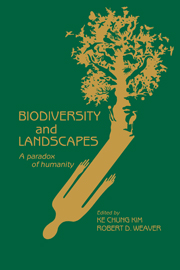Book contents
- Frontmatter
- Contents
- Contributors
- Preface
- Part I Introduction
- Part II Human values and biodiversity
- Part III Human processes and biodiversity
- Part IV Management of biodiversity and landscapes
- Part V Socioeconomics of biodiversity
- Part VI Strategies for biodiversity conservation
- 16 Market-based economic development and biodiversity: an assessment of conflict
- 17 Technology and biodiversity conservation: are they incompatible?
- 18 “Emergy” evaluation of biodiversity for ecological engineering
- 19 Urban horticulture: a part of the biodiversity picture
- 20 The watchdog role of nongovernmental environmental organizations
- 21 Legislative and public agency initiatives in ecosystem and biodiversity conservation
- Part VII Biodiversity and landscapes: postscript
- Index
19 - Urban horticulture: a part of the biodiversity picture
Published online by Cambridge University Press: 04 August 2010
- Frontmatter
- Contents
- Contributors
- Preface
- Part I Introduction
- Part II Human values and biodiversity
- Part III Human processes and biodiversity
- Part IV Management of biodiversity and landscapes
- Part V Socioeconomics of biodiversity
- Part VI Strategies for biodiversity conservation
- 16 Market-based economic development and biodiversity: an assessment of conflict
- 17 Technology and biodiversity conservation: are they incompatible?
- 18 “Emergy” evaluation of biodiversity for ecological engineering
- 19 Urban horticulture: a part of the biodiversity picture
- 20 The watchdog role of nongovernmental environmental organizations
- 21 Legislative and public agency initiatives in ecosystem and biodiversity conservation
- Part VII Biodiversity and landscapes: postscript
- Index
Summary
Introduction
Urban horticulture is plants for cities – functional uses of plants to improve urban environments for the benefit of the people who live there. Functional uses mean screens against unpleasant views and against headlights. It means essential food and special nutrition in the human diet – fruit and vegetable production in cities is important. It means effects upon noise and air pollution and on the amelioration of climates in urban areas. It also means plants to improve the human psyche – plants and gardens are good for people.
Why should we talk about plants in cities? Because most of us live in cities and as world populations expand, more and more people are gathered in tighter and tighter clusters. It includes us all. We get most of our information about city plants from observations and anecdotes, from nurserymen, from landscape architects, and from people who manage properties in the city. For example, the civil engineer in the city knows more about root growth of tree species than does a research scientist because he has to repair the clogged sewer lines and broken pavement caused by urban trees.
Our most substantive information comes from agriculture and forestry. And although the principles of plant growth can be demonstrated equally well with an apple tree, a Douglas fir, or a chrysanthemum, strategies developed from these plants don't apply well when we try to manage rhododendrons in gardens and parks, or a grouping of sweetgum trees along a city street, or the collection of common plants in a backyard, or the rushes and cattails of an urban wetland. Indeed, the whole concept of commercial agriculture is different from urban horticulture.
- Type
- Chapter
- Information
- Biodiversity and LandscapesA Paradox of Humanity, pp. 361 - 370Publisher: Cambridge University PressPrint publication year: 1994

